Raymond W. Bliss
Raymond Whitcomb Bliss (May 17, 1888 – December 12, 1965) was a United States Army medical corps general who served in World War I, World War II, and the Korean War. During his forty-year military career, he researched in innovative practices that advanced the health of those in the military and the civilian sector. Significantly, he was involved with opening the Army's first radioactive isotope laboratory.
Raymond W. Bliss | |
|---|---|
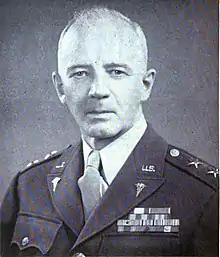 1946 | |
| Born | May 17, 1888 Chelsea, Massachusetts, US |
| Died | December 12, 1965 (aged 77) Tucson, Arizona, US |
| Place of Burial | Arlington National Cemetery, United States |
| Allegiance | |
| Service/ | |
| Years of service | 1911–1951 |
| Rank | |
| Battles/wars | World War I World War II Korean War |
| Spouse(s) | Martha Bliss (nee Stuchel) |
Early life
Bliss was born in Chelsea, Massachusetts, on May 17, 1888.[1][2] His parents were Eli Cooley Bliss and Hannah Page Bliss née Ham.[3][4] He had a sister named Geraldine.[5] Bliss attended Chelsea Public Schools.[4]
Mid-life
Education
In 1910, Bliss graduated as an honor student from Tufts Medical School with a Doctor of Medicine (M.D.) degree.[6][7] In 1911, he became a lieutenant in the Army Medical Reserve Corps.[8] In May 1913, he was accredited as a lieutenant colonel in the US Army Medical Corps. In June of that year, he graduated from the Army Medical School in Washington, D.C.[10] In September 1914, Bliss went to Fort Apache, Arizona, and took his first career position there while it was still an Indian possession.[11]
Bliss went to the Schofield Barracks in Hawaii in May 1915.[12] He returned to the continental United States in August 1917 and went to Camp Wheeler near Macon, Georgia.[12] There he was assigned commander of the base hospital. He moved to West Baden, Indiana, in October 1918 and became commander of General Hospital #35. In May 1919, he transferred to Whipple Barracks in Arizona. There he became commander of General Hospital #20. In February 1920, Bliss took command of Fitzsimons General Hospital in Denver, Colorado.[12]
In August 1920, Bliss entered Harvard Medical School at Boston to learn surgery.[1] He remained there through September 1921 to train and teach medical procedures.[13] He received a degree in surgery from Harvard.[14] In October, he was made commander of the Veterans Hospital in Washington, D.C. Bliss moved to Walter Reed Hospital in January 1923. He transferred to Camp Stephen Little in Arizona in November 1924 and was the main surgeon and officer of medical supplies.[12]
Positions
Bliss was in Manila from 1929 to 1931 and became head of the surgery department at the Sternberg General Hospital.[15] He transferred back to the US, and from 1931 to 1936 helped to establish the Brooke Army Medical Center at Fort Sam Houston, Texas.[16] Bliss was a surgeon from 1936 to 1940 at the William Beaumont General Hospital in El Paso, Texas. He was sent to London as a medical specialist and observer in October 1940 during the German air raids known as the Blitz.[17] He was wounded in November by shrapnel from an air raid, but remained in England until December 1940.[18] Bliss was the commanding officer of Fort Sill hospital in Oklahoma in 1941-1942.[3]
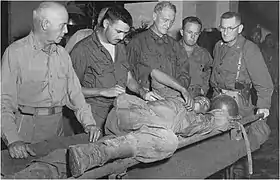
Bliss became a surgeon of the First United States Army and Eastern Defense Command in 1942.[19] He was then delegated to the Surgeon General of the Army's Office as Chief of Operations in July 1943 and became a temporary brigadier general in September. Bliss made many tours of the Pacific areas during World War II and was an observer at the nuclear testing at Bikini Atoll in 1946.[1] He made a two-month inspection of the European and Mediterranean Theaters in late 1946.[15]
In August 1944, Bliss was assistant surgeon general until he was promoted to deputy surgeon general in January 1946.[19][20] He received the permanent rank of brigadier general at that time. Bliss was promoted to the position of Surgeon General of the United States Army by President Harry S. Truman on April 23, 1947.[21] He was officially sworn in on June 1, 1947.[22] He was at that time promoted to the rank of major general.[23] Bliss toured Korea in October 1950 to ascertain the needs of the Army Medical Department during the Korean War.[24] He encouraged the idea of using helicopters as medevac air ambulances.[25][26] He brought in surgeons from the civilian sector and was able to train them with the result that death rates were lower compared to World War I and World War II death rates.[27] This had the side benefit of boosting morale during the war.[13]
Radioactive Isotope Laboratory
Bliss opened the army's radioactive isotope laboratory in March 1949 at Walter Reed Hospital in Washington, D.C.[28] The laboratory consisted of four rooms. Three were used for research laboratories. The fourth room contained the instruments used for radioactive measuring. It was called the counting room, as it counted the radioactivity. The Atomic Energy Commission advised how to construct the laboratory.[29] It had state-of-the-art equipment for analyzing radioactive isotopes. The first projects the atomic researchers carried out involved isotopes of iodine, phosphorus, sodium, and carbon. They were designed to be taken internally by mouth and were radioactive tracers used in the study of blood and thyroid diseases. The isotopes were made at the Oak Ridge National Laboratory in Tennessee.[29] The techniques and innovations developed by this laboratory not only benefited the Army but also the civilian sector.[30] The radioactive isotopes were made available to scientific researchers worldwide a couple of years later.[31] Below are views of the Army's first radioactive isotope laboratory showing the handling and processing of the isotopes.[32]
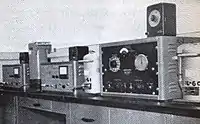 Counting instruments used were kept in room four for measuring the degree of radioactivity of the isotopes
Counting instruments used were kept in room four for measuring the degree of radioactivity of the isotopes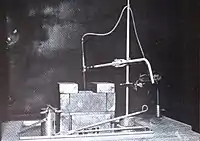 A lead well with a remote control pipetting device and tongs. Radioactive substances were kept inside this well
A lead well with a remote control pipetting device and tongs. Radioactive substances were kept inside this well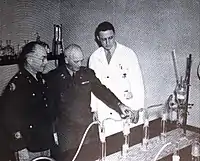 Brigadier General Paul H. Streit,
Brigadier General Paul H. Streit,
Major General Raymond W. Bliss,
Captain Edgar Leifer (white lab coat)
Personal life
Bliss was married to Martha Stuchel on September 15, 1914. She was born in 1888 and was the daughter of attorney John P. Stuchul.[33] Martha was a school teacher at Nogales, Arizona.[16] They had two children, Martha Jane and Raymond Jr.,[1] and six grandchildren.[16]
Awards and legacy

Bliss helped establish the Tripler Army Medical Center in Honolulu, Hawaii.[16] He was the surgeon general of United States Army from 1947-1952.[12] He won an Oscar for Documentary Short Subject at the 21st Academy Awards for the film Toward Independence, June 1949.[34] The Raymond W Bliss Army Health Center at Ft Huachuca, Arizona, is named after him.[35][36]
Later life and death
Bliss retired in May 1951 after 40 years in the military[37][38] with the rank of Major General.[39][40] His permanent residence was at Chocorua, New Hampshire.[41] He spent winters in Tucson visiting his son and daughter.[42] Bliss died at age 77 on December 12, 1965.[16][43] He was being treated at Davis-Mountain Air Force medical facilities near Tucson for a serious chest cold.[44][45] His body was cremated and the ashes buried at Arlington National Cemetery.[43][46][47]
Degrees and honors
- Honorary Doctor of Science degree from Tufts Medical College.[1]
- Honorary Doctor of Laws degree from University of Louisville.[12]
- Order of the Crown of Italy in the grade of Cavaliere Officials.[1]
- Fellow of the American College of Surgeons.[1]
- Distinguished Service Medal.[1][3]
- French Legion of Honor.[1]
- Legion of Merit.[1][3]
References
Citations
- Medical_Dept 1947, p. 572.
- "Finding Even Little Things To Do Brings Contentment". Intelligencer Journal. Lancaster, Pennsylvania. December 8, 1954. p. 1 – via Newspapers.com
 .
. - Miller 1996, p. 24.
- White 2015, p. 315.
- "It Bliss Is Son of General, Has Aunt in Billerica". Boston Globe. Boston, Massachusetts. February 2, 1945. p. 7 – via Newspapers.com
 .
. - "Over 65". The Danville Morning News. Danville, Pennsylvania. December 10, 1953. p. 12 – via Newspapers.com
 .
. - "Find Frederick Tufts Awards Degrees, Medical and Dental Schools also have class day in Medford". The Boston Globe. Boston, Massachusetts. June 15, 1910. p. 12 – via Newspapers.com
 .
. - "Two Claims at Noank". Norwich Bulletin. Norwich, Connecticut. December 7, 1911. p. 11 – via Newspapers.com
 .
. - The Association 1913, p. 50.
- "Raymond Bliss / Ex-Surgeon General Dies at 77". Oakland Tribune. Oakland, California. December 13, 1965. p. 13 – via Newspapers.com
 .
. - "U. S. Army Medical Department/ Medical History". U.S. Army. Retrieved February 17, 2020.
- Steahly 2018, p. 244.
- Record 1947, p. A1992.
- Record 1947, p. A1993.
- "General Bliss Dies here at 77". Tucson Daily Citizen. Tucson, Arizona. December 13, 1965. p. 13 – via Newspapers.com
 .
. - "U.S. Army Sends Five Observers to England". The Decatur Daily Review. Decatur, Illinois. October 11, 1940. p. 1 – via Newspapers.com
 .
. - Cosmas 1992, p. 6.
- War_Depart 1948, p. 2.
- "Chelsea Native to be Deputy Surgeon General". The Boston Globe. Boston, Massachusetts. January 8, 1946. p. 27 – via Newspapers.com
 .
. -
"Bliss Appointed Surgeon General". The Miami News. Miami, Florida. April 23, 1947. p. 7 – via Newspapers.com
 .
. - Release 1947, p. 8.
- "Surgeon General". The Morning Herald. Hagerstown, Maryland. April 26, 1947. p. 1 – via Newspapers.com
 .
. - Williams 2005, p. 59.
- Whitcomb 2011, p. 14.
- Small 2016, p. 82.
- "Raymond W. Bliss". The Boston Globe. Boston, Massachusetts. December 15, 1965. p. 69 – via Newspapers.com
 .
. - Medical_Society 1949, p. 220.
- "Army Studies Isotopes's Use". Berkshire Eagle. Pittsfield, Massachusetts. March 8, 1949. p. 6 – via Newspapers.com
 .
. - "Research Vastly Improves Army's Health, Bringing Sickness to Record Peacetime Low". The Knoxville News-Sentinel. Knoxville, Tennessee. July 12, 1949. p. 12 – via Newspapers.com
 .
. - "No Bomb Scare in Sharing / Isotopes to Be Given to World". Ventura County Star-Free Press. Ventura, California. September 4, 1947. p. 1 – via Newspapers.com
 .
. - Medical_Depart_V9 1949, pp. 425–426.
- "Obituaries / Major General Raymond W. Bliss". The Indiana Gazette. Indiana, Pennsylvania. December 14, 1965. p. 2 – via Newspapers.com
 .
. - Anderson 1968, p. 284.
- Digest Vol 3 1967, p. 4.
- "Dedication Scheduled for Huachuca Hospital". Arizona Daily Star. Tucson, Arizona. July 27, 1967. p. 9 – via Newspapers.com
 .
. - Sangamon 1951, p. 149.
- Johnson 1951, p. 304.
- Newsletter 1972, p. 61.
- Collier 2003, p. 41.
- "Deaths Elsewhere". The Tampa Tribune. Tampa, Florida. December 14, 1965. p. 27 – via Newspapers.com
 .
. - "Raymond W. Bliss". The Boston Globe. Boston, Massachusetts. December 15, 1965. p. 69 – via Newspapers.com
 .
. - White 2015, p. 316.
- "Deaths Elsewhere". The Tampa Tribune. Tampa, Florida. December 14, 1965. p. 27 – via Newspapers.com
 .
. - "Cold Proves Fatal". Estherville Daily News. Estherville, Iowa. December 14, 1965. p. 2 – via Newspapers.com
 .
. - "Gen R. W. Bliss, 77, Ex-U.S. Surgeon". The Boston Globe. Boston, Massachusetts. December 13, 1965. p. 69 – via Newspapers.com
 .
. - Burial Detail: Bliss, Raymond W (section 3, grave 3913-F) – ANC Explorer
Bibliography
| Wikimedia Commons has media related to Raymond W. Bliss. |
- Anderson, Robert S. (1968). Army Medical Specialist Corps. Army Medical Specialist.
- Army-Navy-Air, Register (1918). "Medical Department". Army-Navy-Air Force Register and Defense Times. Army Navy Air Force. 63: 342.
- Collier, Rebecca L. (2003). "Record Group 112". National Archives Records Relating to the Korean War. United States. National Archives and Records Administration. 103: 41.
- Cosmas, Graham A. (1992). Medical Service in the European Theater of Operations. Center of Military History / United States Army /Washington D.C.
- Digest Vol 3 (1967). "Army Dedicates Hospital at Ft. Huachuca, Ariz". Commanders Digest. United States Government. 3: 4.
- Johnson, Wingate Memory (1951). "General Bliss honored". North Carolina Medical Journal. North Carolina Medical Society. 12: 304.
- Medical_Dept, Army (1947). "Raymond W Bliss, Major General, US Arm, The Surgeon General". The Bulletin of the U.S. Army Medical Department. U.S. Government Printing Office. 7: 572.
- Medical_Depart_V9, Army Bulletin (1949). "Isotope Laboratory at the Army Medical Center". The Bulletin of the U.S. Army Medical Department. U.S. Government Printing Office. 9: 425–426.
- Medical_Society, District of Columbia (1949). "Medical Annals". Medical Annals of the District of Columbia. The Medical Society of Washington D. C. 18: 220.
- Miller, Christine Marie (1996). The Biographical Dictionary of World War II Generals and Flag Officers. Greenwood Press. ISBN 0313295468.
- Newsletter (1972). "XXVIII Raymond Whitcomb Bliss /17 May 1888-12 Dec. 1965". Newsletter U.S. Army Medical Department. U. S. Army Medical Depart. 3: 61.
- Record, Department of the Army (1947). "Brig Gen Raymond W Bliss / Extension of remarks of honorable Edith Nourse Rogers of Massachusetts in the House of Representatives, Tuesday April 29 1947". Congressional Record: Proceedings and Debates of the United States Congress. U.S. Department of the Army. 93 (11): 8.
- Release, Department of the Army (1947). "Major General Bliss Takes Oath as Surgeon General of the Army". Immediate Release. U.S. Department of the Army: 8.
- Sangamon (1951). "Bulletin". Bulletin of the Sangamon County Medical Society. Schnepp and Barnet. 16.
- Small, Cathleen (2016). Strategic Inventions of the Korean War. Cavendish Square Publishing. ISBN 978-1502623461.
- Steahly, Lance P. (2018). The Evolution of Forward Surgery in the US Army. Government Printing Office. ISBN 978-0160947841.
- The Association, Military Surgeons of the United States (1913). "Class of 1913". The Military Surgeon. The Association. 32: 50.
- War_Depart, Department of the Army (1948). "Medical Department Chief". Army Information Digest. U.S. Department of the Army. 3: 2.
- Whitcomb, Darrel D. (2011). Call Sign "Dustoff": A History of U.S. Army Aeromedical Evacuation from Conception to Hurricane Katrina. Office of the Surgeon General, Borden Institute. ISBN 978-0160880094.
- White, James Terry (2015). The National Cyclopaedia of American Biography. James Terry White. ISBN 978-0160947841.
- Williams, James W. (2005). A History of Army Aviation. Cavendish Square Publishing. ISBN 9780595673964.
External links
- Films and publications
- Europe / The United Kingdom
- Medical support for a world power
- The European Theater of Operations
- World War II: The Administrative Specialties
- United States Army Medical Service Corps / Korea
- Actions taken in zone of interior / May 1942-October 1943
- Surgeons General of the U.S. Army and Their Predecessors
- The Bulletin of the U. S. Army Medical Department / Combat Psyciatry
- Question of Simplified Organization and Internal Administrative Procedures
- XIII From Auckland to Tokyo – Introductory Note / Observations on Blood Program
- Improvements in the Internal Organization and Administration of Hospitals in the United States
- Raymond W. Bliss at Find a Grave

- Raymond W. Bliss, ArlingtonCemetery•net, an unofficial website